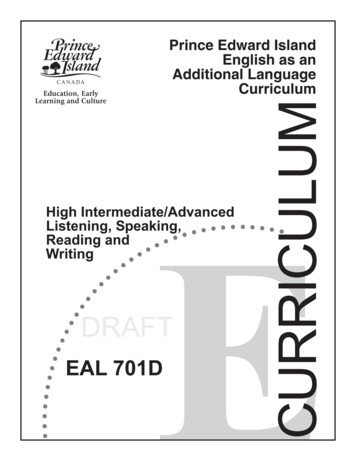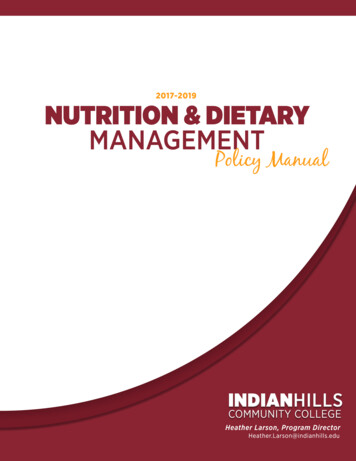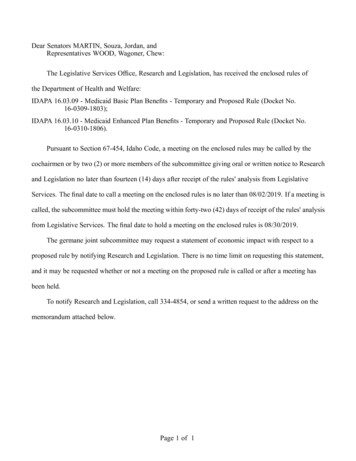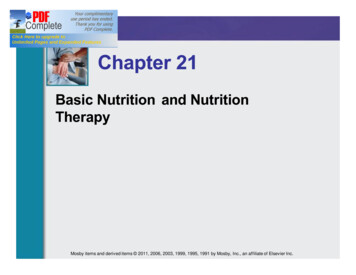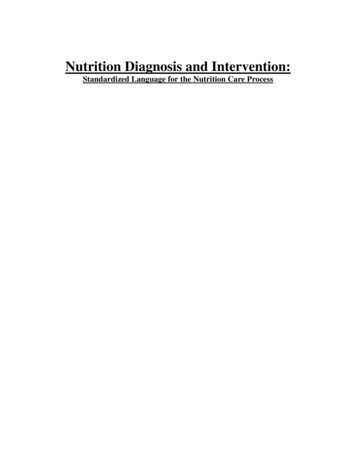
Transcription
Nutrition Diagnosis and Intervention:Standardized Language for the Nutrition Care Process
Nutrition Diagnosis and Intervention:Standardized Language for the Nutrition Care ProcessISBN: 978-0-88091-366-9Copyright 2007, American Dietetic Association. All rights reserved. No part of this publicationmay be reproduced, stored in a retrieval system, or transmitted in any form or by any meanswithout the prior written consent of the publisher. Printed in the United States of America.The views expressed in this publication are those of the authors and do not necessarily reflectpolicies and/or official positions of the American Dietetic Association. Mention of productnames in this publication does not constitute endorsement by the authors or the AmericanDietetic Association. The American Dietetic Association disclaims responsibility for theapplication of the information contained herein.10 9 8 7 6 5 4 3 2 1
Nutrition Diagnosis and Intervention:Standardized Language for the Nutrition Care ProcessTable of ContentsPublication Highlights . 1IntroductionNutrition Diagnosis and Intervention Introduction. 3Nutrition Care Process and Model Article. 7Step 1. Nutrition Assessment Introduction.Nutrition Assessment and Diagnosis Matrix .Food/Nutrition History Data .Anthropometric Data .Biochemical Data, Medical Tests, and Procedures.Physical Examination Data .Client History Data .19222228293235Step 2. Nutrition Diagnosis Introduction.Nutrition Diagnosis Terminology .Nutrition Diagnosis Terms and Definitions.Nutrition Diagnosis Reference Sheets .42495059Step 3. Nutrition Intervention Introduction .Nutrition Intervention Terminology .Nutrition Intervention Terms and Definitions .Nutrition Intervention Reference Sheets.186197198201ResourcesCase Study A and Examples of Charting in Various Formats.Case Study B and Examples of Charting in Various Formats .Implementing Nutrition Diagnosis Article .Scope of Dietetics Practice Framework Article.Standards of Practice in Nutrition Care and Updated Standardsof Professional Performance Article.Standards of Practice in Nutrition Care Appendix .227233241246253258AppendixProcedure for Nutrition Controlled Vocabulary/TerminologyMaintenance/Review. 268AcknowledgmentsTask Force. 278Staff Liaisons, Consultants . 279Expert Reviewers . 280Edition: 2007iv
Nutrition Diagnosis and Intervention:Standardized Language for the Nutrition Care ProcessTable of ContentsFeedback Form . 283Camera-Ready Pocket GuideNutrition Diagnosis . 285Nutrition Intervention . 287Please check the ADA Web site (http://www.eatright.org) for additional materials. Sign in as a member and selectResearch from the sidebar or Practice from the sidebar and then Quality Management.Edition: 2007v
Nutrition Diagnosis and Intervention:Standardized Language for the Nutrition Care ProcessPublication HighlightsPUBLICATIONS RELATED TO THE NUTRITION CARE PROCESSSince its development, several publications related to the Nutrition Care Process have beendeveloped by the American Dietetic Association (ADA). In addition to this publication, there aretwo articles published in the Journal of the American Dietetic Association and one publicationavailable regarding the Nutrition Care Process and Model. The original article published in the2003 Journal described the complete nutrition care process (1). Another 2005 Journal articledescribed the implementation of Nutrition Diagnosis, Step 2 in the nutrition care process (2).Similarly, the first publication, entitled Nutrition Diagnosis: A Critical Step in the Nutrition CareProcess, examined only Nutrition Diagnosis (3).This publication is intended to illustrate the evolution of the nutrition care process since itsintroduction in 2003 and provide tools for practitioners to implement the nutrition care processinto their practice.NEW IN THIS PUBLICATIONThis publication addresses the first three steps in the nutrition care process: Nutrition Assessment,Nutrition Diagnosis, and Nutrition Intervention.The Nutrition Assessment section is NEW and provides a matrix illustrating the nutritionassessment data associated with the nutrition diagnoses. It is beyond the scope of this publicationto define the nutrition assessment data with a standard taxonomy, as this has been doneelsewhere in the dietetics literature.The Nutrition Diagnosis section reflects the CHANGES to the nutrition diagnoses since thepublication of the book—Nutrition Diagnosis: A Critical Step in the Nutrition Care Process—introduced at ADA’s 2005 Food and Nutrition Conference and Exhibition.The Nutrition Intervention section is NEW and uses a standard taxonomy to describe thenutrition interventions performed by dietetics professionals. A research study is underway toassess the usability and validity in clinical settings of the terms. The taxonomy is grouped intofour classes of nutrition interventions: Food and/or Nutrient Delivery, Nutrition Education,Nutrition Counseling, and Coordination of Care. The terminology used is defined and referencesheets for each specific nutrition intervention are available for use now by the profession. Apractitioner will note that while some interventions are very closely related (e.g., education andcounseling), the terms are intentionally separated to distinguish between them. Further, it isbelieved that the information necessary for medical record documentation, billing, and thedescription of the nutrition interventions for research are included in the terminology.Edition: 20071
The nutrition intervention section describes the two interrelated components of nutritionintervention—planning and implementation. It also illustrates how the nutrition diagnosisstatement, also called the PES (problem, etiology, signs/symptoms) statement, labels theproblems and identifies where the nutrition intervention is aimed to address the problem.Specific descriptors (e.g., individuals or groups, face to face or electronically) of a nutritionintervention encounter (i.e., interactions, visits, contacts, sessions) are also provided.NOT INCLUDED IN THIS PUBLICATIONThe Nutrition Monitoring and Evaluation (Step 4) section was deliberately omitted from thispublication since a great deal of research is underway regarding the nutrition diagnosis andnutrition intervention terminology that may impact the nutrition monitoring and evaluationcomponent of the nutrition care process. Therefore, the research data will be examined beforeterms are defined and categorized for this step. Future publications will provide updates to thefirst three steps and examine the fourth and final step, nutrition monitoring and evaluation.REFERENCES1. Lacey K, Pritchett E. Nutrition care process and model: ADA adopts road map to quality careand outcomes management. J Am Diet Assoc. 2003;103:1061-1072.2. Mathieu J, Foust M, Ouellette P. Implementing nutrition diagnosis, step two in the nutritioncare process and model: Challenges and lesions learned in two health care facilities. J AmDiet Assoc. 2005;105:1636-1640.3. American Dietetic Association. Nutrition Diagnosis: A Critical Step in the Nutrition CareProcess. Chicago, IL: American Dietetic Association; 2006.Edition: 20072
Nutrition Diagnosis and Intervention:Standardized Language for the Nutrition Care ProcessINTRODUCTIONContinually emerging from the American Dietetic Association’s (ADA) strategic plan arepriority actions that guide work groups and taskforces in creating tools to advance the dieteticsprofession. In 2002, to achieve the Association’s strategic goals of promoting demand fordietetic professionals and help them be more competitive in the marketplace, the ADA QualityManagement Committee appointed the Nutrition Care Model Workgroup. This Workgroupdeveloped the Nutrition Care Process and Model, a systematic process describing how dieteticsprofessionals provide care with patients/clients (1).The nutrition care process is designed to improve the consistency and quality of individualizedpatient/client care and the predictability of the patient/client outcomes. It is not intended tostandardize nutrition care for each patient/client but to establish a standardized process forproviding care. Of note, the terms patient/client are used in association with the nutrition careprocess; however, the process is also intended for use with groups. In addition, family membersor caregivers of patients/clients are not specified, yet they can be an essential asset to thepatient/client and professional in the nutrition care process. Therefore, groups and families andcaregivers of patients/clients are implied each time a reference is made to patient/client.There are four steps in the process—Nutrition Assessment, Nutrition Diagnosis, NutritionIntervention, and Nutrition Monitoring and Evaluation. Three of the nutrition care process stepsare very familiar to dietetics professionals and nutrition textbooks skillfully cover their content—nutrition assessment, nutrition intervention, and nutrition monitoring and evaluation. However,the Workgroup identified a less well-defined aspect of nutrition care: nutrition diagnosis. Further,it recognized that a standard taxonomy for the second step in the process would greatly enhancethe profession’s ability to document, communicate, and research its impact.As a result, the ADA’s Standardized Language Task Force was formed to create a taxonomy forthe profession’s unique nutrition diagnosis language. The language was described duringpresentations at the 2005 Food and Nutrition Conference and Exhibition and made available in apublication at that meeting (2). This language is currently being studied in a number of researchprojects and future modifications will be made based on these analyses.Because the nutrition care process and, in particular, nutrition diagnosis represent a monumentalchange in the approach to nutrition services, the Standardized Language Task Force hasexamined, to this point, two other steps in the process: nutrition assessment and nutritionintervention. Therefore, this publication illustrates the evolution of the nutrition care process andprovides tools for practitioners to implement the process into their practice.Edition: 20073
NUTRITION CARE PROCESS STEPSStep 1. Nutrition AssessmentNutrition assessment is the first step in the process and is a method for obtaining, verifying, andinterpreting data that is needed to identify a nutrition-related problem. From the nutritionassessment data, the practitioner is able to determine whether a nutrition diagnosis/problemexists. This step, while well-known to practitioners, offers many opportunities for continuedresearch, which will result in improved determinations of the most appropriate nutritionassessment data to use for individuals and populations.Step 2: Nutrition DiagnosisNutrition diagnosis is the new component in the nutrition care process, and is a critical stepbetween nutrition assessment and nutrition intervention. The purpose of a standardized nutritiondiagnosis language is to consistently describe nutrition problems so that they are clear within andoutside the profession. The standard language will enhance communication and documentationof nutrition care, and it will provide a minimum data set and common data elements for futureresearch.In simple terms, a nutrition diagnosis identifies and labels a specific nutrition problem that adietetics professional is responsible for treating independently. A nutrition diagnosis is oftentemporary, and with nutrition intervention the nutrition diagnosis ideally resolves. This is incontrast to medical diagnosis, which is a disease or pathology of organs or body systems (e.g.,diabetes), and does not change as long as the condition exists.ADA’s Standardized Language Task Force developed a framework that outlines threedomains—Clinical, Intake, and Behavioral-Environmental—within which thediagnoses/problems fall. Sixty-two diagnoses/problems have been identified. A reference wasdeveloped and it describes each diagnosis/problem and incorporates expert input (2).It is this step in the nutrition care process that results in the nutrition diagnosis statement or PESstatement. This statement is composed of three distinct components: the problem (P), theetiology (E) and the signs and symptoms (S). The PES statement is derived from the synthesis ofinformation from the nutrition assessment data.Step 3: Nutrition InterventionNutrition intervention is the third step in the nutrition care process. Nutrition interventions arespecific actions used to remedy a nutrition diagnosis/problem, and can be used with individuals,a group, or the community at large. These Interventions are intended to change a nutrition-relatedbehavior, risk factor, environmental condition, or aspect of nutritional health. A dieteticsprofessional collaborates, whenever possible, with the patient/client(s) and other health careproviders during the nutrition intervention.Nutrition intervention consists of two interrelated components—planning and implementation.Planning involves prioritizing the nutrition diagnoses; conferring with the patient, others, andpractice guides and policies; jointly establishing goals; and defining the nutrition prescriptionand specific nutrition intervention. Implementing the nutrition intervention is the action phase,Edition: 20074
which includes carrying out and communicating the plan of care, continuing the data collection,and revising the nutrition intervention, as warranted, based on the patient/client response. Thisstep cannot be completed unless both components are in place to support the nutritionintervention.The nutrition intervention is, almost always, aimed at the etiology (E) of the nutritiondiagnosis/problem identified in the PES statement. In very specific instances, the nutritionintervention is directed at the signs and symptoms (S) to reduce the signs and symptoms.Generally the signs and symptoms form the basis for the next step in the nutrition care process:nutrition monitoring and evaluation (Step 4).Four main classes of nutrition intervention have been identified—Food and/or Nutrient Provision,Nutrition Education, Nutrition Counseling, and Coordination of Care. The terminology is definedand reference sheets for each specific nutrition intervention are available for use by theprofession. It is believed that the information necessary for medical record documentation,billing, and the description of the nutrition interventions for research are included in theterminology.A practitioner will note that while some interventions are closely related (e.g., education andcounseling), the terms are intentionally separated to distinguish between them. Additionally,specific descriptors of a nutrition intervention encounter (i.e., interactions, visits, contacts,sessions) are provided to assist a practitioner with the details of his/her encounters withpatient/client(s). Examples of descriptors include encounters with individuals or groups, face toface or electronically, and the degree to which the practitioner is responsible for the patient/clientcare, to name a few.Step 4: Nutrition Monitoring and EvaluationA great deal of progress has been made in articulating the first three nutrition care process steps.Research is underway and a deliberate decision was made to review the data emerging from thenutrition diagnosis and nutrition intervention terms before work is attempted to categorize anddefine terms for this step. Dietetics professionals should continue to employ nutrition monitoringand evaluation strategies and tools that are currently available until this step is further defined inthe context of the nutrition care process.NUTRITION CARE PROCESS AND MEDICAL NUTRITION THERAPYThe nutrition care process and medical nutrition therapy (MNT) are not synonymous terms.MNT is one aspect of nutrition care, whereas, the nutrition care process describes the approachto a spectrum of nutrition care. The nutrition care process defines specific steps a practitioneruses when providing MNT. Other activities, such as referral to a community program, are notMNT, but are part of the nutrition care process.Edition: 20075
IMPLEMENTATION OF THE NUTRITION CARE PROCESS AND FUTURE DIRECTIONSSeveral exciting projects are ongoing, including pilot tests of individual steps as well as multiplesteps in the nutrition care process. Although it may seem practical to wait until the nutrition careprocess is fully articulated, practitioners and educators are encouraged to use the nutrition careprocess now and participate in its development and evolution.International Information Sharing and Standardized Medical LanguagesIn 2005, the ADA Foundation funded an ADA hosted meeting to expand the dialogue with otherinternational dietetic associations about ADA’s standardized nutrition diagnosis language andsimilar efforts other associations have made. The meeting also initiated a dialogue between theforemost medical informatics organizations and the international nutrition and dieteticscommunity.Indeed, as the world moves fully into electronic health care records, health informatics, andcommon databases, the international community of nutrition and dietetics professionals have theopportunity to work in partnership with the medical informatics organizations to ensure that dataelements critical to capturing nutrition care are included in databases and collected in aconsistent way.When these relationships are established, ADA will formally submit the nutrition diagnosisterms to the nationally recognized health care databases and medical informatics languages andrequest that the terms are added to their language databases.SUMMARYThis publication illustrates, to date, the first three steps in the nutrition care process and providestools for practitioners to implement the process in their practice. Future publications will provideupdates to the first three steps and examine the fourth and final step: nutrition monitoring andevaluation.From conception of the nutrition care process in 2002 through its implementation now, theStandardized Language Task Force continues to update ADA’s House of Delegates, the Board ofDirectors, and members through reports, articles, presentations, publications, and the ADA Website.However, to see the strategic goals of an increased demand for dietetic professionals who aremore competitive in the marketplace come to fruition, professionals need to take a historic stepby implementing the nutrition care process today.REFERENCES1. Lacey K, Pritchett E. Nutrition care process and model: ADA adopts road map to quality careand outcomes management. J Am Diet Assoc. 2003;103:1061-1072.2. American Dietetic Association. Nutrition Diagnosis: A Critical Step in the Nutrition CareProcess. Chicago, IL: American Dietetic Association; 2006.Edition: 20076
OF PROFESSIONAL INTERESTNutrition Care Process and Model: ADA adopts roadmap to quality care and outcomes managementKAREN LACEY, MS, RD; ELLEN PRITCHETT, RDprofessionals, including nursing, physical therapy, and occupational therapy, utilize defined care processes specific to theirprofession (4-6). When asked whether ADA should develop astandardized Nutrition Care Process, dietetics professionalswere overwhelmingly in favor and strongly supportive of havinga standardized Nutrition Care Process for use by registereddietitians (RD) and dietetics technicians, registered (DTR).The Quality Management Committee of the House of Delegates (HOD) appointed a Nutrition Care Model Workgroup inMay 2002 to develop a nutrition care process and model. Thefirst draft was presented to the HOD for member input andreview in September 2002. Further discussion occurred duringthe October 2002 HOD meeting, in Philadelphia. Revisionswere made accordingly, and the HOD unanimously adopted thefinal version of the Nutrition Care Process and Model on March31, 2003 “for implementation and dissemination to the dieteticsprofession and the Association for the enhancement of thepractice of dietetics.”he establishment and implementation of a standardizedNutrition Care Process (NCP) and Model were identified aspriority actions for the profession for meeting goals of theADA Strategic Plan to “Increase demand and utilization of services provided by members” and “Empower members to compete successfully in a rapidly changing environment” (1). Providing high-quality nutrition care means doing the right thing atthe right time, in the right way, for the right person, and achieving the best possible results. Quality improvement literatureshows that, when a standardized process is implemented, lessvariation and more predictability in terms of outcomes occur(2). When providers of care, no matter their location, use aprocess consistently, comparable outcomes data can be generated to demonstrate value. A standardized Nutrition Care Process effectively promotes the dietetics professional as theunique provider of nutrition care when it is consistently used asa systematic method to think critically and make decisions toprovide safe and effective nutrition care (3).This article describes the four steps of ADA’s Nutrition CareProcess and the overarching framework of the Nutrition CareModel that illustrates the context within which the NutritionCare Process occurs. In addition, this article provides the rationale for a standardized process by which nutrition care is provided, distinguishes between the Nutrition Care Process andMedical Nutrition Therapy (MNT), and discusses future implications for the profession.TSETTING THE STAGEDefinition of Quality/Rationale for a StandardizedProcessThe National Academy of Science’s (NAS) Institute of Medicine (IOM) has defined quality as “The degree to which healthservices for individuals and populations increase the likelihoodof desired health outcomes and are consistent with currentprofessional knowledge” (7,8). The quality performance of providers can be assessed by measuring the following: (a) theirpatients’ outcomes (end-results) or (b) the degree to whichproviders adhere to an accepted care process (7,8). The Committee on Quality of Health Care in America further states thatit is not acceptable to have a wide quality chasm, or a gap,between actual and best possible performance (9). In an effortto ensure that dietetics professionals can meet both requirements for quality performance noted above, the American Dietetic Association (ADA) supports a standardized NutritionCare Process for the profession.BACKGROUNDPrior to the adoption of this standardized Nutrition Care Process, a variety of nutrition care processes were utilized by practitioners and taught by dietetics educators. Other allied healthK. Lacey is lecturer and Director of Dietetic Programsat the University of Wisconsin-Green Bay, Green Bay. Sheis also the Chair of the Quality Management Committee.E. Pritchett is Director, Quality and Outcomes at ADAheadquarters in Chicago, IL.If you have questions regarding the Nutrition Care Process and Model, please contact Ellen Pritchett, RD, CPHQ,Director of Quality and Outcomes at ADA,epritchett@eatright.orgCopyright 2003 by the American Dietetic Association.0002-8223/03/10308-0014 35.00/0doi: 10.1053/jada.2003.50564Standardized Process versus Standardized CareADA’s Nutrition Care Process is a standardized process fordietetics professionals and not a means to provide standardizedcare. A standardized process refers to a consistent structureand framework used to provide nutrition care, whereas stanJournal of THE AMERICAN DIETETIC ASSOCIATION / 1061Edition: 20077
OF PROFESSIONAL INTERESTFIG 1. ADA Nutrition Care Process and Model.achieve an outcome and/or any activity or set of activities thattransforms inputs to outputs.(b) Process Approach is the systematic identification andmanagement of activities and the interactions between activities. A process approach emphasizes the importance of thefollowing: understanding and meeting requirements; determining if the process adds value; determining process performance and effectiveness; and using objective measurement for continual improvement ofthe process (13).(c) Critical Thinking integrates facts, informed opinions, active listening and observations. It is also a reasoning process inwhich ideas are produced and evaluated. The Commission onAccreditation of Dietetics Education (CADE) defines criticalthinking as “transcending the boundaries of formal educationto explore a problem and form a hypothesis and a defensibleconclusion” (14). The use of critical thinking provides a uniquestrength that dietetics professionals bring to the Nutrition CareProcess. Further characteristics of critical thinking include theability to do the following: conceptualize; think rationally; think creatively; be inquiring; and think autonomously.dardized care infers that all patients/clients receive the samecare. This process supports and promotes individualized care,not standardized care. As represented in the model (Figure 1),the relationship between the patient/client/group and dieteticsprofessional is at the core of the nutrition care process. Therefore, nutrition care provided by qualified dietetics professionals should always reflect both the state of the science and thestate of the art of dietetics practice to meet the individualizedneeds of each patient/client/group (10).Using the NCPEven though ADA’s Nutrition Care Process will primarily beused to provide nutrition care to individuals in health care settings (inpatient, ambulatory, and extended care), the processalso has applicability in a wide variety of community settings. Itwill be used by dietetics professionals to provide nutrition careto both individuals and groups in community-based agenciesand programs for the purpose of health promotion and diseaseprevention (11,12).Key TermsTo lay the groundwork and facilitate a clear definition of ADA’sNutrition Care Process, key terms were developed. These definitions provide a frame of reference for the specific components and their functions.(a) Process is a series of connected steps or actions to1062 / August 2003 Volume 103 Number 8Edition: 20078
OF PROFESSIONAL INTERESTand professional autonomy. Professional autonomy resultsfrom being recognized for what we do well, not just for who weare. When quality can be demonstrated, as defined previouslyby the IOM (7,8), then dietetics professionals will stand out asthe preferred providers of nutrition services. The NutritionCare Process, when used consistently, also challenges dieteticsprofessionals to move beyond experience-based practice toreach a higher level of evidence-based practice (9,10).The Nutrition Care Process does not restrict practice butacknowledges the common dimensions of practice by the following: defining a common language that allows nutrition practice tobe more measurable; creating a format that enables the process to generate quantitative and qualitative data that can then be analyzed and interpreted; and serving as the structure to validate nutrition care and showing how the nutrition care that was provided does what it intends to do.(d) Decision Making is a critical process for choosing the bestaction to meet a desired goal.(e) Problem Solving is the process of the following: problem identification; solution formation; implementation; and evaluation of the results.(f) Collaboration is a process by which several individuals orgroups with shared concerns are united to address an identifiedproblem or need, leading to the accomplishment of what eachcould not do separately (15).DEFINITION OF ADA’S NCPUsing the terms and concepts described above, ADA’s Nutrition Care Process is defined as “a systematic problem-solvingmethod that dietetics professionals use to critic
The Nutrition Diagnosis section reflects the CHANGES to the nutrition diagnoses since the publication of the book—Nutrition Diagnosis: A Critical Step in the Nutrition Care Process— introduced at ADA's 2005 Food and Nutrition Conference and Exhibition. The Nutrition Intervention section is NEW and uses a standard taxonomy to describe the




